Trace Elements and Mineralogy of Upper Permian (Zechstein) Potash Deposits in Poland
Abstract
:1. Introduction
2. Geological Setting
3. Previous Geochemical Studies of Zechstein Potash-Bearing Deposits in Poland
3.1. Sulphate (Polyhalites) and Chloride K–Mg Salts of PZ1 (Werra) Cyclothem from Northern Poland
3.2. K–Mg Salts of PZ2 (Stassfurt) and PZ3 (Leine) Cyclothems from SALT Domes in Central Poland
3.3. K–Mg Salts of PZ2 (Stassfurt) and PZ3 (Leine) Cyclothems from the Fore-Sudetic Area (SW Poland)
4. Materials and Methods
4.1. Rock Material
4.2. Geochemical Analyses
- -
- Ba, Cr, Cu, Fe, Mn, Sr, Ti, V, and Zn—emission atomic spectrometry with activation in inductively coupled plasma (ICP-OES);
- -
- Ag, As, Be, Ce, Cd, Co, Cs, Ga, La, Li, Mo, Ni, Pb, Rb, Sb, Se, Sn, Tl, and U—mass spectrometry with ionization in inductively coupled plasma (ICP-MS);
- -
- Br and I—ion chromatography (IC).
4.3. Mineral Composition Study
4.4. Petrographic Studies
5. Geology and Sampling of Potash-Bearing Deposits
5.1. Sulphate K–Mg Salts
5.2. Potash-Bearing Deposits of PZ2 Cyclothem
5.3. Potash-Bearing Deposits of PZ3 Cyclothem
6. Results
6.1. Mineral Composition of Potash-Bearing Deposits
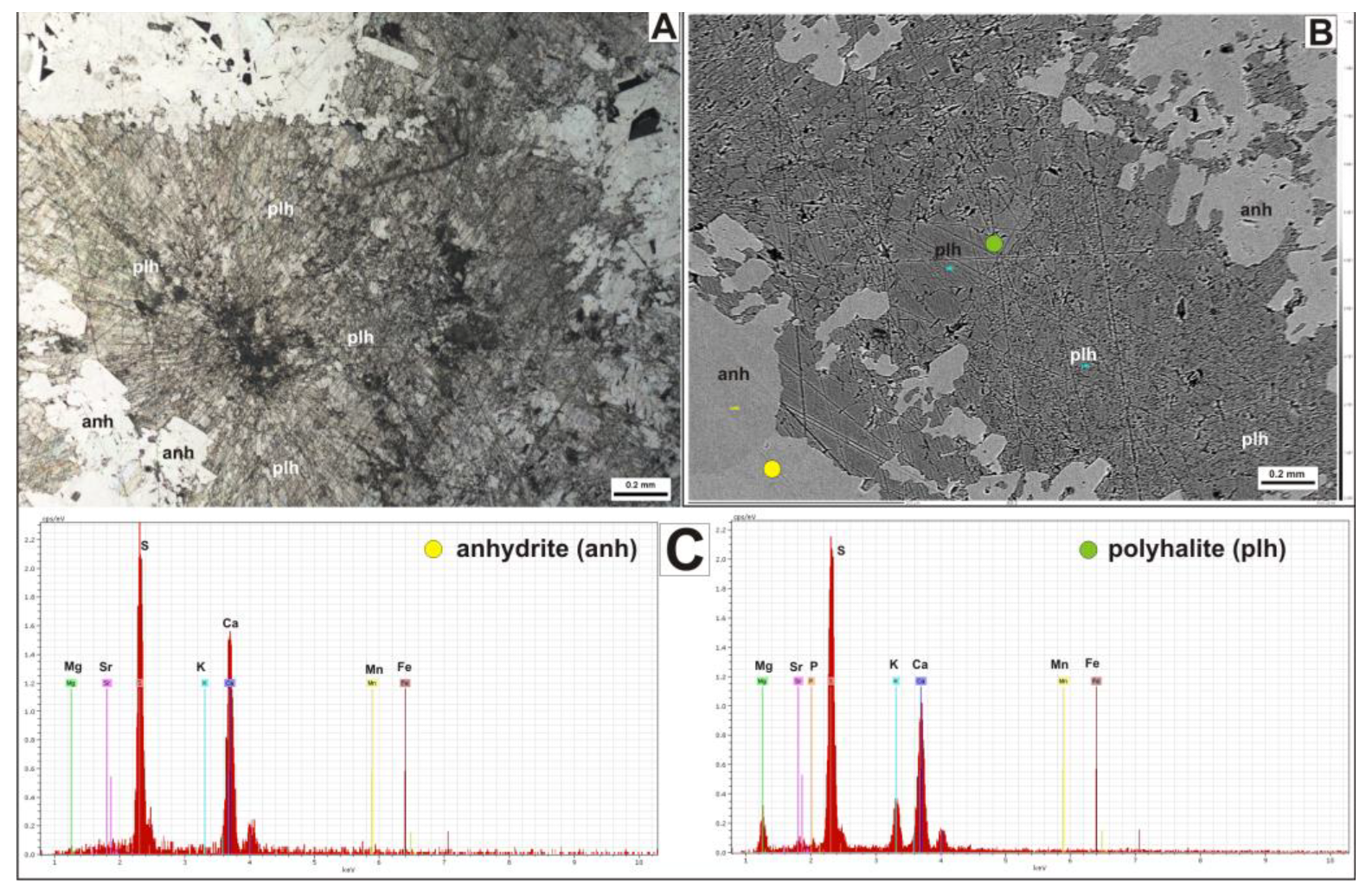
6.2. Trace Elements Study
6.2.1. Sulphate K–Mg Salts (Polyhalite)
6.2.2. Potash-Bearing Deposits of PZ2 Cyclothem
6.2.3. Potash-Bearing Deposits of PZ3 Cyclothem
7. Conclusions
Author Contributions
Funding
Institutional Review Board Statement
Informed Consent Statement
Data Availability Statement
Acknowledgments
Conflicts of Interest
References
- Alonso, R.N. On the origin of La Puna Borates. Acta Geol. Hisp. 1999, 34, 141–166. [Google Scholar]
- Mohr, S.H.; Mudd, G.M.; Giurco, D. Lithium resources and production: Critical assessment and global projection. Minerals 2012, 2, 65–84. [Google Scholar] [CrossRef]
- Munk, L.A.; Hynek, S.A.; Bradley, D.C.; Boutt, D.; Labay, K.; Jochens, H. Lithium brines: A global perspective. Rev. Econ. Geol. 2016, 18, 339–365. [Google Scholar]
- Munk, L.A.; Boutt, D.F.; Moran, B.J.; McKnight, S.V.; Jenckes, J. Hydrogeologic and Geochemical Distinctions in Freshwater-Brine Systems of an Andean Salar. Geochem. Geophys. Geosystems 2021, 22, 1–20. [Google Scholar] [CrossRef]
- Mazurek, S.; Roszkowska-Remin, J.; Szamałek, K.; Tymiński, M.; Malon, A. Scarce mineral commodities for the Polish economy—A new proposal for approach to strategic and critical mineral commodities. Prz. Geol. 2021, 69, 273–286, (In Polish with English Abstract and Captions). [Google Scholar]
- Szlugaj, J.; Radwanek-Bąk, B. Lithium sources and their current use. Miner. Resour. Manag. 2022, 38, 61–88. [Google Scholar]
- Bąbel, M.; Schreiber, B. Geochemistry of Evaporites and Evolution of Seawater. In Treatise on Geochemistry, 2nd ed.; Turekian, K., Holland, H., Eds.; Elsevier Ltd.: Singapore, 2013; pp. 483–560. ISBN 9780080959757. [Google Scholar]
- Belenitskaya, G. Salt Systems of the Earth: Distribution, Tectonic and Kinematic History, Salt-Naphthids Interrelations, Discharge Foci, Recycling; Scriver Publishing, Wiley & Sons Inc.: Beverly Hills, CA, USA, 2019; ISBN 978-1-119-47905-5. [Google Scholar]
- Hardie, L.A. Evaporites: Marine or Non Marine? Am. J. Sci. 1984, 284, 193–240. [Google Scholar] [CrossRef]
- Hardie, L.A.; Smoot, J.P.; Eugster, H.P. Saline Lakes and Their Deposits: A Sedimentological Approach, 2nd ed.; IAS Special Publications; Blackwell Scientific Publications: Oxford, United KingdomUK, 1978. [Google Scholar]
- Hovorka, S.D. Quaternary evolution of playa lakes on the Southern High Plains—A case study from the Amarillo area, Texas. Bur. Econ. Geol. Rep. Investig. 1995, 236, 1–52. [Google Scholar]
- Kendall, A.C. Evaporites. In Facies Models; Walker, R.G., James, N.P., Eds.; Geological Association of Canada: St. John’s, Canada, 1992; pp. 375–409. [Google Scholar]
- Kendall, A.C.; Harwood, G.M. Marine evaporites: Arid shorelines and basins. In Sedimentary Environments. Processes, Facies and Stratigraphy; Reading, H.G., Ed.; Blackwell Science Ltd.: Oxford, United Kingdom, 1996; pp. 281–324. [Google Scholar]
- Schreiber, C.B. Evaporites and Hydrocarbons; Columbia University Press: New York, NY, USA, 1988. [Google Scholar]
- Schreiber, B.C.; El Tabakh, M. Deposition and early alternation of evaporites. Sedimentology 2000, 47, 215–238. [Google Scholar] [CrossRef]
- Sonnenfeld, P. Marine evaporite facies. Zd. Geol. Paläont. 1991, I, 1107–1136. [Google Scholar]
- Warren, J.K. Evaporites: Sediments, Resources and Hydrocarbons; Springer: Berlin/Heidelberg, Germany; New York, NY, USA, 2006; ISBN 3-540-26011-0. [Google Scholar]
- Warren, J.K. Evaporites. A Geological Compendium, 2nd ed.; Springer International Publishing: Switzerland, 2016; ISBN 9783319135113. [Google Scholar]
- Risacher, F.; Fritz, B. Bromine geochemistry of salar de Uyuni and deeper salt crusts, Central Altiplano, Bolivia. Chem. Geol. 2000, 167, 373–392. [Google Scholar] [CrossRef]
- Risacher, F.; Fritz, B. Origin of salars and brine evolution of Bolivian and Chilean salars. Aquat. Geochem. 2009, 15, 123–157. [Google Scholar] [CrossRef]
- Risacher, F.; Alonso, H.; Salazar, C. The origin of brines and salts in Chilean salars; a hydrochemical review. Earth Sci. Rev. 2003, 63, 249–293. [Google Scholar] [CrossRef]
- U.S Geological Survey, Mineral Commodity Summaries. January 2022. Available online: https://pubs.usgs.gov (accessed on 25 June 2022).
- Boschetti, T.; Cortecci, G.; Barbieri, M.; Mussi, M. New and past geochemical data on fresh to brine waters of the Salar de Atacama and Andean Altiplano, northern Chile. Geofluids 2007, 7, 33–50. [Google Scholar] [CrossRef]
- Amado, F.A.; Godfrey, L. Potential sources of lithium in the Salar de Atacama: A geochemical and isotopic approach. In Proceedings of the Goldschmidt Conference, Paris, France, 13–18 August 2017. [Google Scholar]
- Godfrey, L.; Amado, F.A. Volcanic and Saline Lithium Inputs to the Salar de Atacama. Minerals 2020, 10, 201. [Google Scholar] [CrossRef] [Green Version]
- Garcia, M.G.; Borda, L.G.; Godfrey, L.V.; Lópetz Steinmetz, R.L.; Losada-Calderon, A. Characterization of lithium cycling in the Salar De Olaroz, Central Andes, using a geochemical and isotopic approach. Chem. Geol. 2020, 531, 119–340. [Google Scholar] [CrossRef]
- Gozalvez, M. Li-rich salt lakes and borates in the Argentine Puna. In Proceedings of the 15th Quadrennial International Association on the Genesis of Ore Deposits Symposium Field Trip 3, Salta, Argentina, 1–3 September 2018. [Google Scholar]
- López Steinmetz, R.L. Litium- and boron-bearing bines in the Central Andes: Exploring hydrofacies on the eastern Puna plateau between 23° and 23030″S. Miner. Depos. 2017, 52, 35–50. [Google Scholar] [CrossRef] [Green Version]
- López Steinmetz, R.L.; Salvi, S.; Sarchi, C.; Santamans, C.; López Steinmetz, L.C. Lithium and Brine Geochemistry in the Salars of the Southern Puna, Andean Plateau of Argentina. Econ. Geol. 2020, 115, 1079–1096. [Google Scholar] [CrossRef]
- Du, Y.; Fan, Q.; Gao, D.; Wei, H.; Shan, F.; Li, B.; Zhang, X.; Yuan, Q.; Qin, Z.; Ren, Q.; et al. Evaluation of boron isotopes in halite as an indicator of the salinity of Qarham paleolake water in the eastern Qaidam Basin, western China. Geosci. Front. 2019, 10, 253–262. [Google Scholar] [CrossRef]
- Czapowski, G.; Peryt, T.M.; Tomassi-Morawiec, H.; Handke, B.; Wachowiak, J. Valuation of Selected Trace Elements Content in the Potash Salts. Final Report of the Project “Support of the Chief Geologist Activity in the Government Policy of Mineral Resources”; Archives of PGI-NRI: Warsaw, Poland, 2020; pp. 1–41. (In Polish) [Google Scholar]
- Szybist, A. Rock salt deposit in the Legnica-Głogów Copper District. Prz. Geol. 1976, 24, 572–576. (In Polish) [Google Scholar]
- Werner, Z. Report on Geology and Resources of the Potassium-Magnesium Salts Deposit in Kłodawa; Archives of PGI-NrI: Warsaw, Poland, 1958; pp. 1–58. (In Polish) [Google Scholar]
- Werner, Z. Report on Geology and Resources of the Potassium-Magnesium Salts Deposit in the Kłodawa Salt Dome; Archives of PGI-NRI: Warsaw, Poland, 1962; pp. 1–58. (In Polish) [Google Scholar]
- Werner, Z. Report on Geology and Resources (C1 Category) of the Rock Salt Deposit Nearby the Puck Bay; Archives of PGI-NRI: Warsaw, Poland, 1979; pp. 1–183. (In Polish) [Google Scholar]
- Werner, Z. Report on Geology and Resources of the “Swarzewo” Polyhalite Deposit, Puck Commune; Archives of PGI-NRI: Warsaw, Poland, 1971; pp. 1–119. (In Polish) [Google Scholar]
- Werner, Z. Report on Geology and Resources of the “Zdrada” Polyhalite Deposit, Puck Commune; Archives of PGI-NRI: Warsaw, Poland, 1971; pp. 1–138. (In Polish) [Google Scholar]
- Werner, Z.; Orska, E.; Kotowski, A.; Wrotnowska, B. Geological Report of the Chłapowo-Mieroszyno” Polyhalite and Rock Salt Deposit; Archives of PGI-NRI: Warsaw, Poland, 1967; pp. 1–383. (In Polish) [Google Scholar]
- Garlicki, A.; Szybist, A. Trace elements in salts of the Kłodawa Mine. Prace Specj. Pol. Tow. Min. 1991, 1, 1–71. (In Polish) [Google Scholar]
- Garlicki, A.; Szybist, A.; Kasprzyk, A. Studies of trace elements in the deposits of salt and chemical raw minerals. Prz. Geol. 1991, 39, 520–527, (In Polish with English Summary and Captions). [Google Scholar]
- Kasprzyk, A. Strontium content in the Miocene gypsum rocks in the Staszów region. Prz. Geol. 1989, 37, 201–207, (In Polish with English Summary and Captions). [Google Scholar]
- Kasprzyk, A. Regularities of strontium distribution in Miocene gypsum south of the Holy Cross Mts. (Central Poland). Prz. Geol. 1993, 41, 416–421, (In Polish with English Summary and Captions). [Google Scholar]
- Kasprzyk, A. Distribution of strontium in the Badenian (Middle Miocene) gypsum deposits of the Nida area, southern Poland. Geol. Q. 1994, 38, 497–512. [Google Scholar]
- Peryt, T.M.; Pobereżski, A.W.; Jasionowski, M.; Petryczenko, O.I.; Peryt, D.; Ryka, W. Badenian gypsum facies of Ponidzie and Naddniestrze areas. Prz. Geol. 1994, 42, 771–777, (In Polish with English Summary and Captions). [Google Scholar]
- Rosell, L.; Orti, F.; Kasprzyk, A.; Playa, E.; Peryt, T.M. Strontium geochemistry of Miocene primary gypsum: Messinian of SE Spain and Sicily and Badenian of Poland. J. Sediment. Res. 1998, 68, 63–79. [Google Scholar] [CrossRef]
- Tomassi-Morawiec, H. Bromine geochemistry of the Oldest Halite deposits in the Puck Bay area. Biul. PIG 1990, 364, 31–59, (In Polish with English Summary and Captions). [Google Scholar]
- Tomassi-Morawiec, H. Bromine and strontium in the Oldest Halite (Na1) on the Łeba elevation area (a case of Orle ONZ-1 borehole). Prz. Geol. 2001, 49, 384–388, (In Polish with English Summary and Captions). [Google Scholar]
- Tomassi-Morawiec, H. Geochemical characteristics of the Oldest Halite (Na1) nearby the Puck Bay. Prz. Geol. 2003, 51, 693–702, (In Polish with English Summary and Captions). [Google Scholar]
- Tomassi-Morawiec, H.; Czapowski, G.; Bornemann, O.; Schramm, M.; Tadych, J.; Misiek, G.; Kolonko, P.; Janiów, S. Standard bromide profiles for Zechstein salt deposits of Poland: Salts of PZ3 (Z3) cycle in Kłodawa Salt Mine. Miner. Resour. Manag. 2007, 23, 103–115, (In Polish with English Abstract and Captions). [Google Scholar]
- Tomassi-Morawiec, H.; Czapowski, G.; Toboła, T.; Iwasińska-Budzyk, I.; Narkiewicz, W.; Misiek, G.; Janiów, S.; Chęciński, R. Standard Bromide Profiles as and a Tool of Dating and Internal Subdivision of Zechstein Salt Units in the Poland Area; Final report of KBN Fund no 4T12B 002 29; Archives of PGI-NRI: Warsaw, Poland, 2008. (In Polish) [Google Scholar]
- Wachowiak, J. Mineralogical Study of Chemical and Silicilastic Rocks from the Kłodawa Salt Dome. Ph.D. Thesis, Archives of the AGH University of Science and Technology, Cracow, Poland, 1998. (In Polish). [Google Scholar]
- Wachowiak, J. Lithostratigraphic and Bromine Profile of the Zechstein Salt Series in the Area of Borehole M-29 of the Mogilno Salt Dome. Salt Rev. 2015, 11, 91–97. [Google Scholar]
- Wachowiak, J. Lithostratigraphy and geochemistry of the Zechstein salt series drilled by M-35 borehole in Mogilno salt dome. Salt Rev. 2016, 12, 114–126, (In Polish with English Abstract and Captions). [Google Scholar]
- Czapowski, G. Calculations of salt basin depth and deposition time of salts, exemplified by the Oldest Halite (Na1) unit from the Zechstein PZ1 cycle at the Puck Bay (northern Poland). Prz. Geol. 2007, 55, 573–581, (In Polish with English Summary and Captions). [Google Scholar]
- Wagner, R. Stratigraphy and evolution of the Zechstein basin in the Polish Lowland. Pr. PIG 1994, 146, 1–71, (In Polish with English Summary and Captions). [Google Scholar]
- Słowakiewicz, M.; Mikołajewski, Z. Upper Permian Main Dolomite microbial carbonates as potential source rocks for hydrocarbons (W Poland). Mar. Pet. Geol. 2011, 28, 1572–1591. [Google Scholar] [CrossRef]
- Bornemann, O.; Behlau, J.; Fischbeck, R.; Hammer, J.; Jaritz, W.; Keller, S.; Mingerzahn, G.; Schramm, M. Standortbeschreibung Gorleben, Teil 3: Ergebnisse der über- und untertägigen Erkundung des Salinars. Geol. Jahrb. 2008, 73, 1–211. [Google Scholar]
- Richter-Bernburg, G. Zechstein Salt Correlation: English-Denmark-Germany; Geological Society, Special Publications: London, UK; Blackwell Scientific Publications: Oxford, UK, 1986; Volume 22, pp. 165–168. [Google Scholar]
- Roth, H. Stratigraphie. A. Perm; Erl. geol. Kte. Hessen 1:25 00, Bl. 5224.; Erl Geol Kte Hessen: Eiterfeld, Germany, 1991; pp. 16–20. [Google Scholar]
- Steinhoff, I.; Strohmenger, C. Facies differentiation and sequence stratigraphy in ancient evaporite basins—An example from the basal Zechstein (Upper Permian of Germany). Carbonates Evaporites 1999, 14, 146–181. [Google Scholar]
- STDK. Stratigraphische Tabelle von Deutschland Kompakt; Menning, M., Heindrich, A., Eds.; Deutsche Stratigraphische Kommission: Potsdam, Germany, 2017. [Google Scholar]
- Szurlies, M. Magnetostratigraphy of the Zechstein: Implications for the Late Permian geological time-scale. Schr. Dtsch. Ges. Geowiss. 2020, 89, 129–143. [Google Scholar]
- Peryt, T.M.; Wagner, R. Zechstein evaporite deposition in the Central European Basin: Cycles and stratigraphic sequences. J. Seism. Explor. 1998, 7, 201–218. [Google Scholar]
- Wagner, R. Stratigraphie des höhsten Zechstein in Polnischen Zentralbecken. Zbl. Geol. Paläont. 1991, I, 883–892. [Google Scholar]
- Wagner, R.; Peryt, T.M. Possibility of sequence stratigraphy subdivision of the Zechstein in the Polish Basin. Geol. Q. 1997, 41, 457–474. [Google Scholar]
- ICC 2021 (International Chronostratigraphic Chart); International Commission on Stratigraphy: July 2021. Available online: http://wwww.strtatigraphy.org/ICSchart/ChronostratChart2021-07.pdf (accessed on 20 February 2022).
- Czapowski, G.; Bukowski, K. Geology and resources of salt deposits in Poland: The state of the art. Geol. Q. 2010, 54, 509–518. [Google Scholar]
- Czapowski, G.; Tomassi-Morawiec, H.; Chełmiński, J.; Tomaszczyk, M. Recognition stage and management prospects of Zechstein salt deposits nearby the Puck Bay. Surf. Min. 2008, XLX/II, 47–55, (In Polish with English Abstract and Captions). [Google Scholar]
- Czapowski, G.; Bukowski, K.; Mazurek, S. Rock salt and potassium-magnesium salts. In Balance of Prospective Resource of Minerals in Poland; Szamałek, K., Szuflicki, M., Mizerski, W., Eds.; Polish Geological Institute: Warsaw, Poland, 2020; pp. 218–232. (In Polish) [Google Scholar]
- Orska, J.; Werner, Z. Rock and potassium salt. In Geology of Poland. Vol. VI: Mineral Deposits; Osika, R., Ed.; Geological Institute: Warsaw, Poland, 1987; pp. 197–205. [Google Scholar]
- Werner, Z. Potash deposits nearby the Puck Bay. In Giude of 54. Meeting of Polish Geological Society; Cetniewo: Warsaw, Poland, 1972; pp. 37–46. (In Polish) [Google Scholar]
- Stępniewski, M. Some trace elements in the Zechstein salt minerals from the Puck Bay nearby. Biuletin IG 1973, 272, 7–68, (In Polish with English Abstract and Captions). [Google Scholar]
- Pasieczna, A. Mineralogical-geochemical studies of the Zechstein sulphate deposits from the Puck Bay nearby. Archiw. Mineral. 1987, 43, 19–40, (In Polish with English Abstract and Captions). [Google Scholar]
- Peryt, T.M. Genesis of the polyhalite deposits in the Zechstein nearby the Puck Bay after results of sedimentological and geochemical. Prz. Geol. 1995, 43, 1041–1044, (In Polish with English Summary and Captions). [Google Scholar]
- Peryt, T.M.; Czapowski, G.; Dębski, J.; Gąsiewicz, A.; Herbich, E.; Pizon, A. Prospection of Zechstein Polyhalite Deposits on the Łeba elevation. Part I. Analyse of Geological Conditions of Polyhalite and Zechstein Salts on the Łeba Elevation; Archives of PGI-NRI: Warsaw, Poland, 1984; pp. 1–100. (In Polish) [Google Scholar]
- Werner, Z. Bromide Content Study in the Zechstein-Salt Bearing Deposits and in the Potash Salts; Archives of PGI-NRI: Warsaw, Poland, 1954; pp. 1–58. (In Polish) [Google Scholar]
- Mazurek, S.; Burliga, S.; Wiśniewski, A.; Staszczak, W.; Misiek, Ł.; Kurdek, D.; Bartłomiejczak, G. Supplement No 2 to Report on Geology and Resources of the Kłodawa 1” Salt Deposit; Archives of PGI-NRI: Warsaw, Poland, 2016; pp. 1–52. (In Polish) [Google Scholar]
- Tomassi-Morawiec, H.; Czapowski, G.; Bornemann, O.; Schramm, M.; Misiek, G. Standard bromine profiles of the Polish Zechstein salts. Miner. Resour. Manag. 2009, 25, 75–143, (In Polish with English Abstract and Captions). [Google Scholar]
- Czapowski, G.; Tomassi-Morawiec, H.; Tadych, J.; Grzybowski, Ł.; Sztyrak, T. Bromine geochemistry and characteristics of Zechstein salt rocks in selected core materials from the Góra salt diapir near Inowrocław. Geologia 2009, 35, 287–305, (In Polish with English Summary and Captions). [Google Scholar]
- Schramm, M.; Bornemann, O. Bromine Profile and Stratigraphic Study of the Mogilno M-24 Borehole. Report of Investigations; Archives of IKS SOLINO: Inowrocław, Poland, 2006; (In Polish and English). [Google Scholar]
- Czapowski, G.; Tomassi-Morawiec, H.; Toboła, T.; Tadych, T. Geology, geochemistry and petrological characteristics of potash salt units from PZ2 and PZ3 Zechstein (Late Permian) cycles in Poland. Geol. Geophys. Environ. 2012, 38, 153–188. [Google Scholar] [CrossRef] [Green Version]
- Peryt, T.M.; Pierre, C.; Gryniv, S.P. Origin of polyhalite deposits in the Zechstein (Upper Permian) Zdrada platform (northern Poland). Sedimentology 1998, 45, 565–578. [Google Scholar] [CrossRef]
- Peryt, T.M.; Tomassi-Morawiec, H.; Czapowski, G.; Hryniv, S.P.; Pueyo, J.J.; Eastoe, C.J.; Vovnyuk, S. Polyhalite occurrence in the Werra (Zechstein, Upper Permian) Peribaltic Basin of Poland and Russia: Evaporite facies constraints. Carbonates Evaporites 2005, 20, 182–194. [Google Scholar] [CrossRef]
- Peryt, T.M. Lower and Upper Werra Anhydrite in Leba Elevation area (northern Poland). Lithofacies and paleogeography. Zb. Geol. Paläont 1991, I, 1189–1200. [Google Scholar]
- Peryt, T.M. The anatomy of a sulphate platform and adjacent basin system in the Łeba sub-basin of the Lower Werra Anhydrite (Zechstein, Upper Permian), northern Poland. Sedimentology 1994, 41, 83–113. [Google Scholar] [CrossRef]
- Czapowski, G. Upper Permian (Zechstein) salt deposits on the Żary Pericline—Characteristics, origin and economic value. Pr. PIG 1995, 150, 35–60. [Google Scholar]
- Podemski, M. Zechstein rock and potash salts of Z2 and Z3 cyclothems nearby Nowa Sól. Biul. IG 1972, 260, 5–62, (In Polish with English Abstract and Captions). [Google Scholar]
- Podemski, M. Zechstein sedimentation in the western part of Fore-Sudetic Monocline nearby Nowa Sól. Pr. Inst. Geol. 1973, 71, 1–101, (In Polish with English Abstract and Captions). [Google Scholar]
- Podemski, M. Stratigraphy of Zechstein deposits from the western part of North-Sudetic Depression. Kwart. Geol. 1974, 18, 729–748, (In Polish with English Abstract and Captions). [Google Scholar]
- Podemski, M. Results of hitherto done studies of potash salts in the Fore-Sudetic area. Prz. Geol. 1974, 21, 7–12, (In Polish with English Summary and Captions). [Google Scholar]
- Podemski, M. Zechstein salts from the Rybaki structure. Biul. IG 1975, 286, 5–63, (In Polish with English Abstract and Captions). [Google Scholar]
- Burliga, S.; Kolonko, P.; Misiek, G.; Czapowski, G. Kłodawa Salt Mine. Upper Permian (Zechstein) profile from basin center, salt tectonics, mineral transformations, salt mining problems. In XIII International Congress on Carboniferous-Permian Guide to Excursion A3; Maliszewska, A., Wagner, R., Eds.; Polish Geological Institute: Warsaw, Poland, 1995; pp. 45–54. [Google Scholar]
- Misiek, G. Stratigraphy and characteristics of Zechstein deposits in the Kłodawa salt diapir. In Conference Materials on Salt Tectonics of the Kujawy Region, Uniejów 23-25.10.1997; Burliga, S., Ed.; WIND: Wrocław, Poland, 1997; pp. 20–23. (In Polish) [Google Scholar]
- Podemski, M. The Older Potash horizon nearby Zielona Góra.; Archives of PGI-NSI: Warsaw, Poland, 1972; pp. 1–184. (In Polish) [Google Scholar]
- Manecki, A. Detailed Mineralogy; Mineral Press: Kraków, Poland, 2019; ISBN 978-83-933330-5-9. (In Polish) [Google Scholar]
- Sonnenfeld, P. Brines and Evaporites; Academic Press, Inc.: London, UK, 1984; ISBN 0-12-654780-7. [Google Scholar]
- Okrusch, M.; Hartwig, E.; Frimmel, L. Mineralogy. An Introduction to Minerals, Rocks, and Mineral Deposits; Springer GmbH: Stuhr, Germany, 2020; ISBN 978-3-662-57314-3. Available online: www.mindat.org (accessed on 20 January 2022). [CrossRef]
- Łaszkiewicz, A. Salt minerals and rocks. Pr. Muz. Ziemi 1967, 11, 101–188. (In Polish) [Google Scholar]
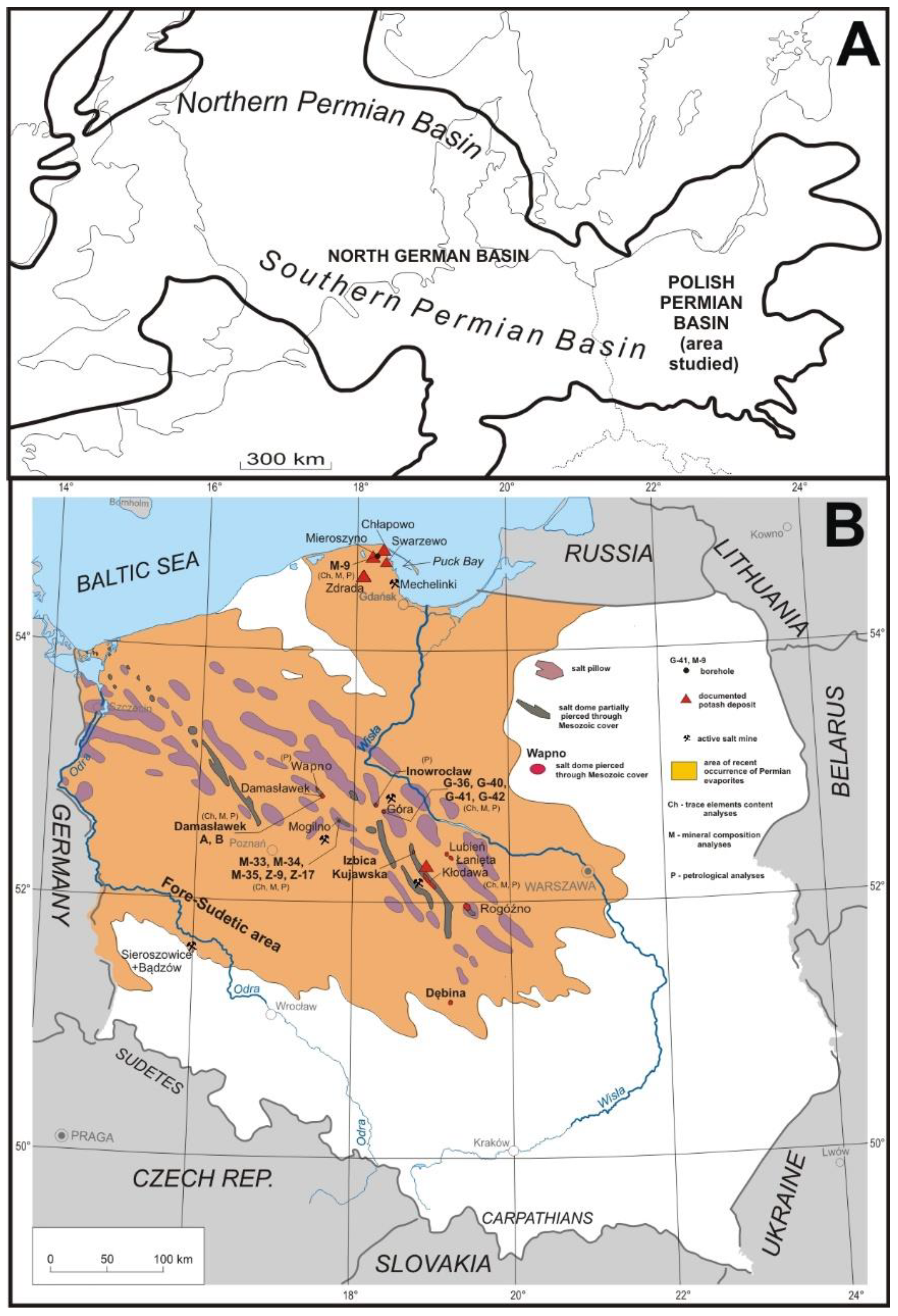
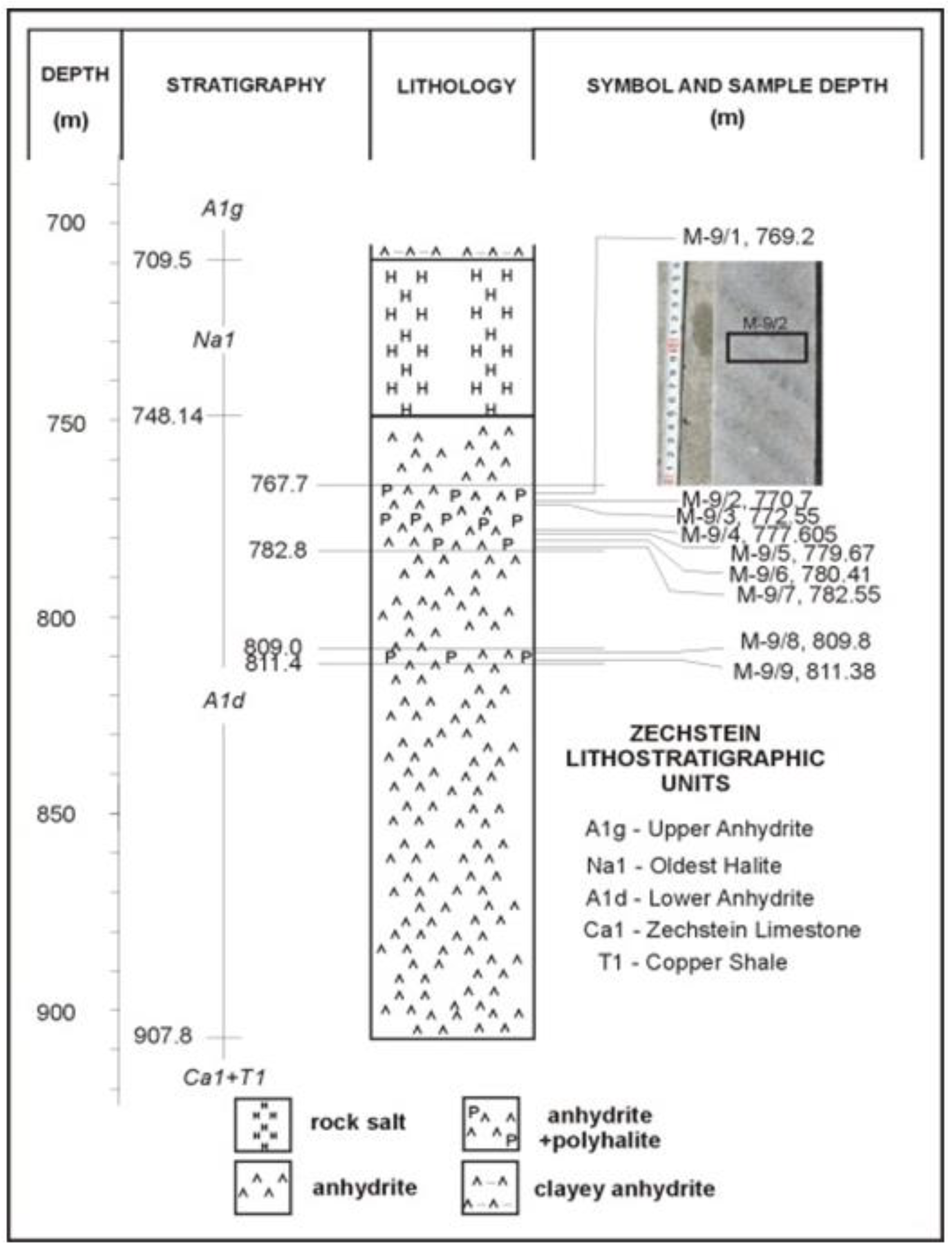
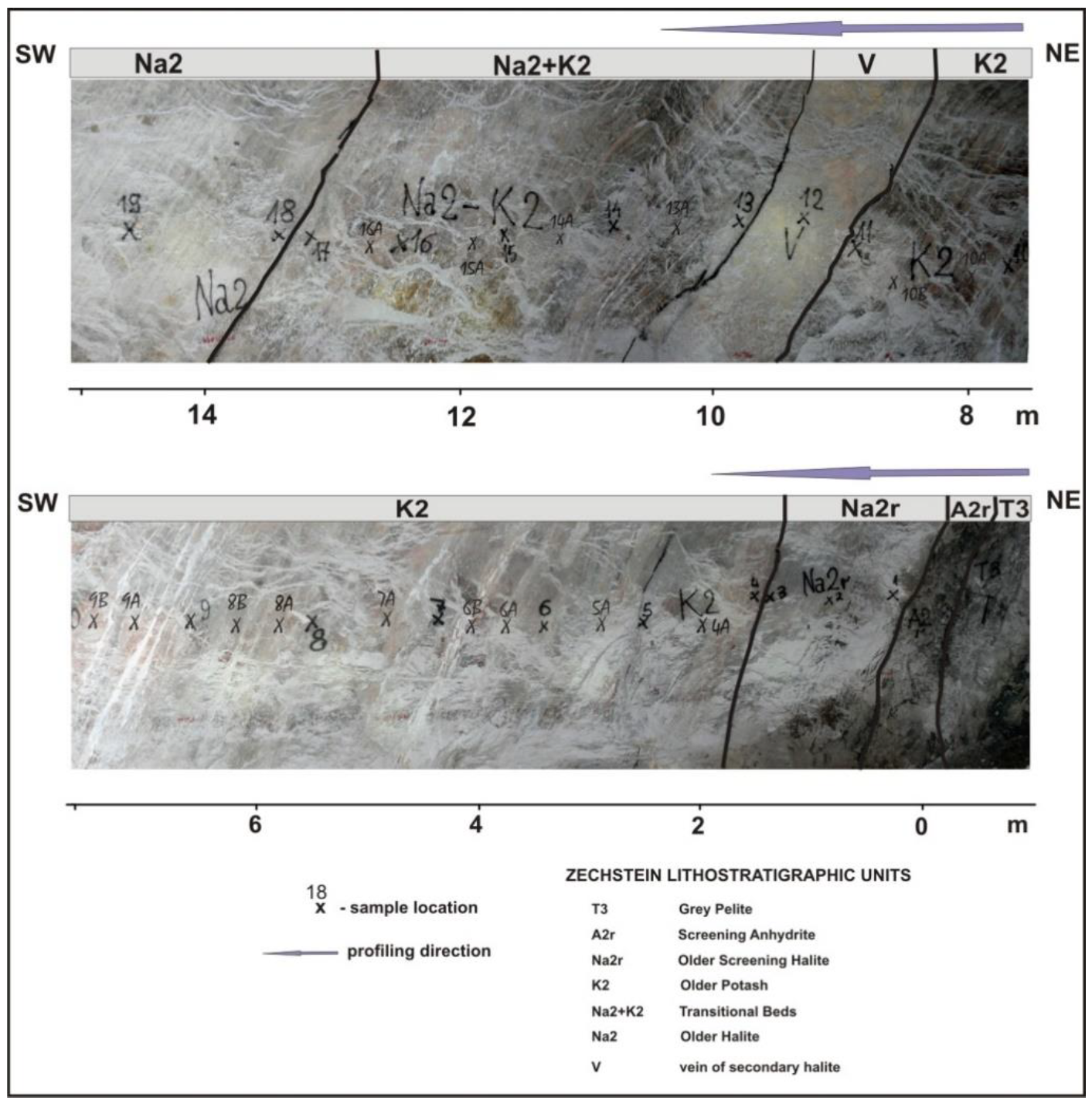
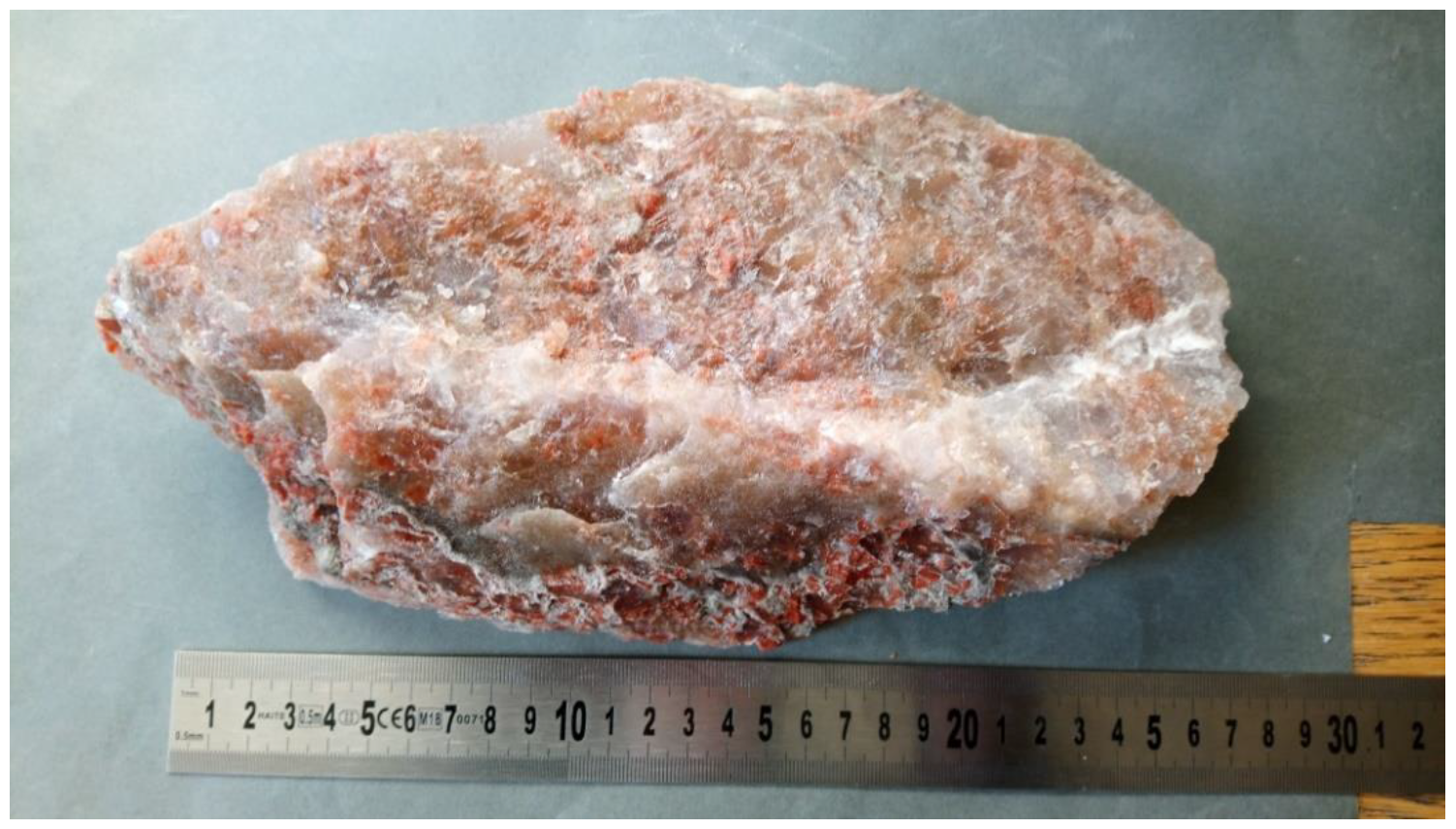
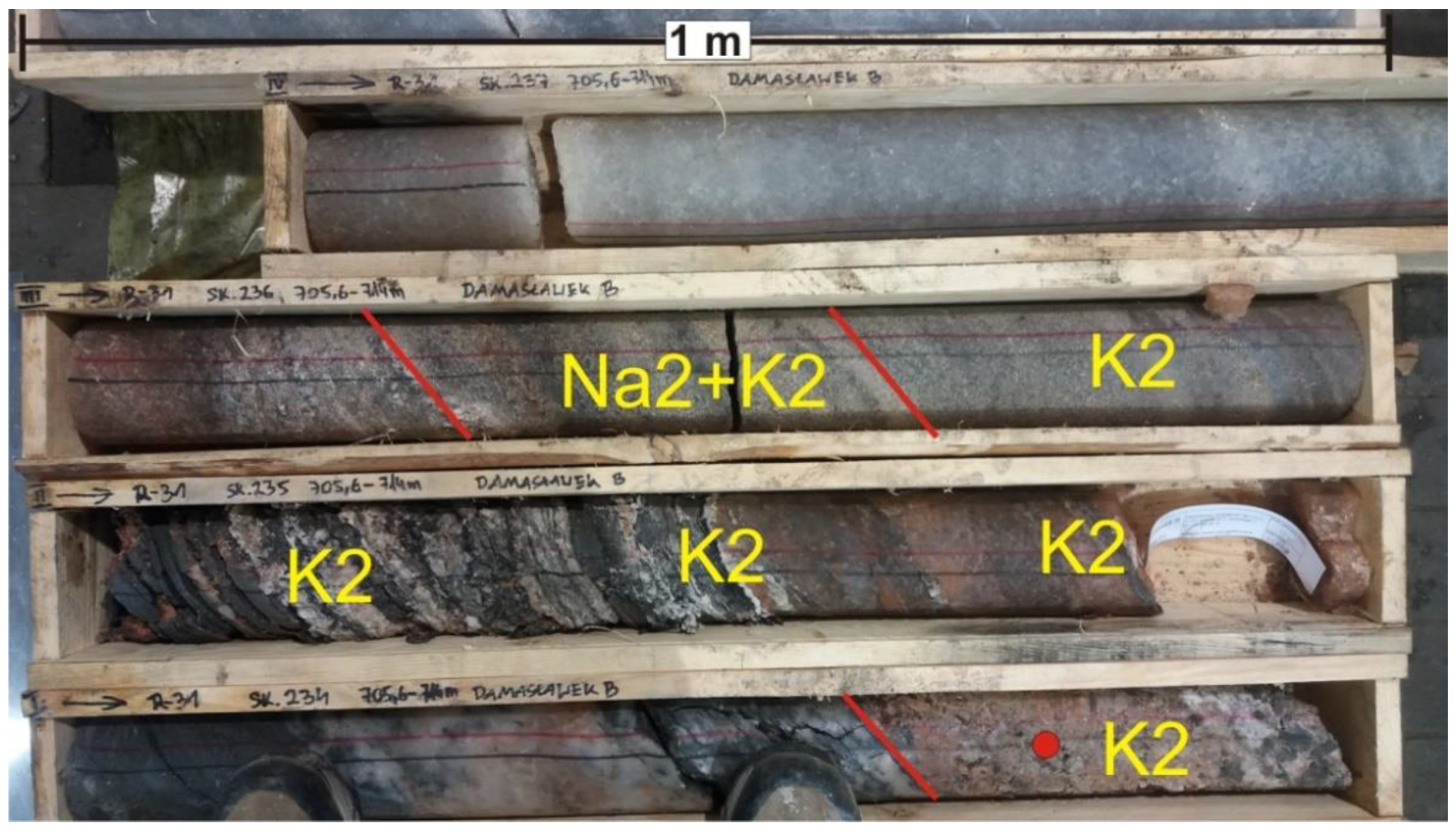


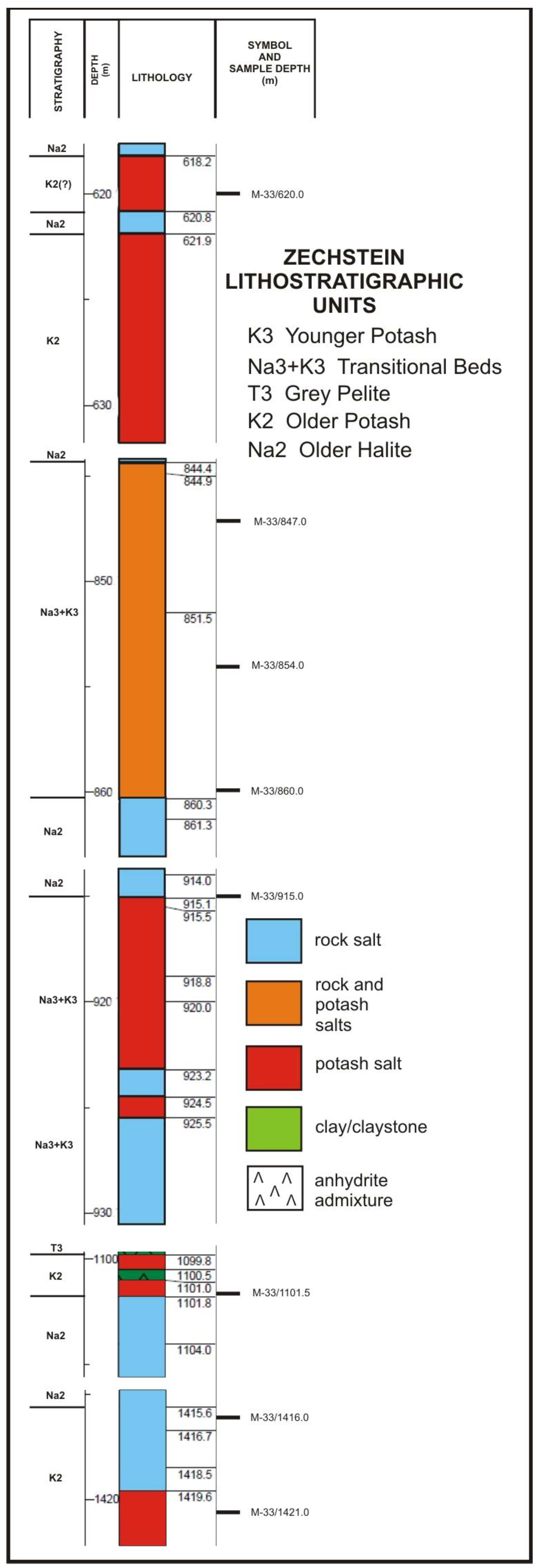


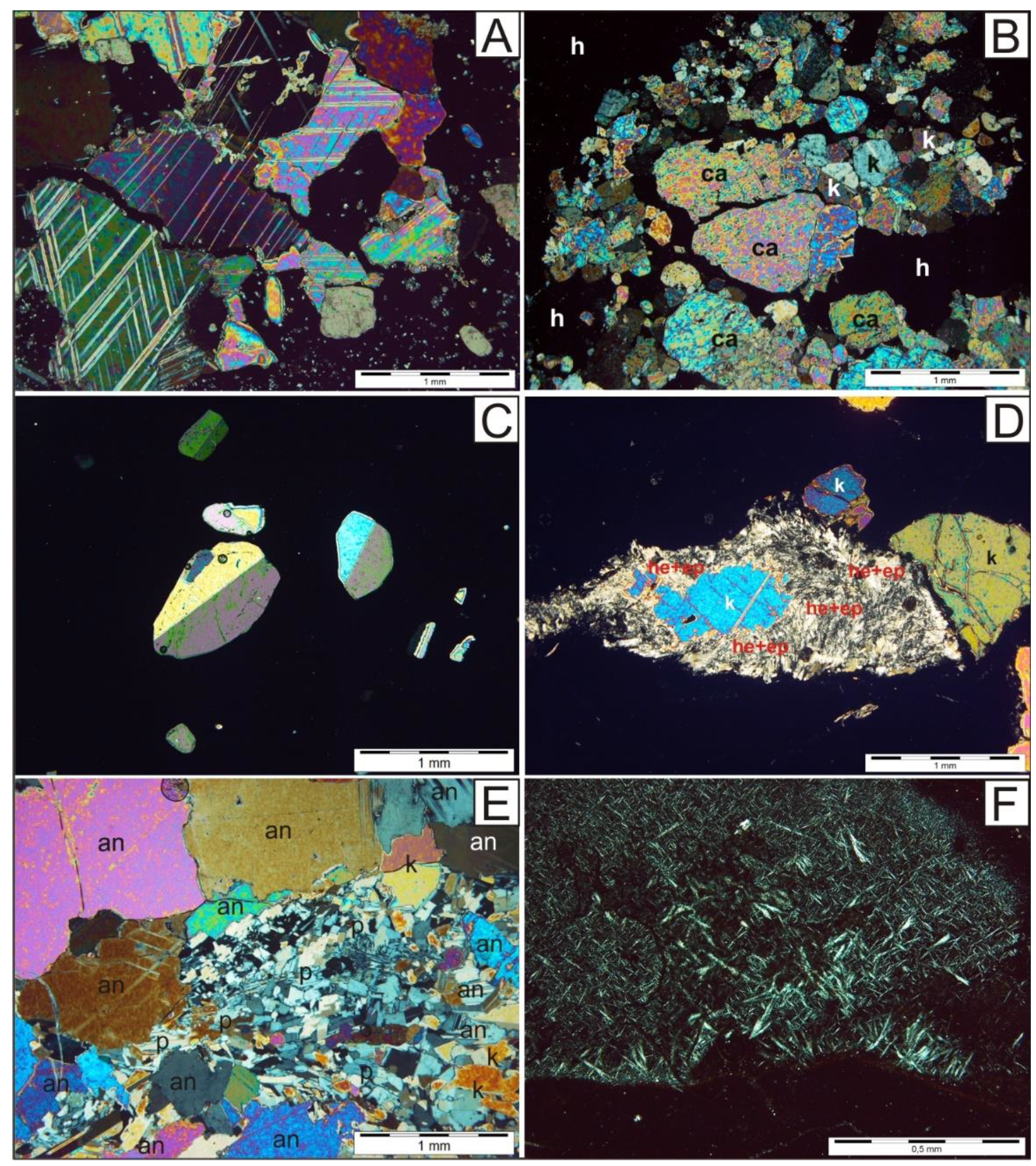
| Global Stratigraphic Units [62,66] | European Regional Stratigraphic Units [61] | Evaporite Zechstein Lithostratigraphic Units in Poland [55] (modyfied) | |||
|---|---|---|---|---|---|
| Epoch | Age | Stage | Group | Name and Symbol of Unit | Cyclothems |
| Lopingian | Wuchiapingian | Thuringian | Zechstein | Brown Zuber (Na3t) | PZ3 |
| upper Younger Halite (Na3b) | |||||
| Younger Potash (K3) | |||||
| Transitional beds Na3+K3 | |||||
| lower Younger Halite (Na3a) | |||||
| Main Anhydrite (A3) | |||||
| Screening Anhydrite (Na2r) | PZ2 | ||||
| Screening Halite (Na2r) | |||||
| Older Potash (K2) | |||||
| Transitional beds Na2+K2 | |||||
| Older Halite (Na2) | |||||
| Basal Anhydrite (A2) | |||||
| Upper Anhydrite (A1g) | PZ1 | ||||
| Oldest Halite (Na1) | |||||
| Lower Anhydrite (A1d) (with polyhalite) | |||||
| Zechstein Lithostratigraphic Units | Number of Samples | Number of Samples | ||||
|---|---|---|---|---|---|---|
| Puck Bay Surroundings | Góra Salt Dome | Damasławek Salt Dome | Mogilno Salt Dome | Kłodawa Salt Dome | ||
| Polyhalites within A1d | 9 | - | - | - | - | 9 |
| Na2+K2, K2 | - | 1 | 11 | 7 | 73 | 92 |
| Na3+K3, K3 | - | 4 | 4 | 6 | 193 | 207 |
| Number of samples | 9 | 5 | 15 | 13 | 266 | 308 |
| Location | Zechstein Lithostratigraphic Units | Type of Analyse | ||
|---|---|---|---|---|
| Chemical (Elements Content) | XRD (Mineral Composition) | Petrographic (Mineral Composition) | ||
| Puck Bay surroundings | A1d | 9 | 2 | 8 |
| Góra salt dome | Na2+K2, K2 | 1 | 1 | 6 |
| Na3+K3, K3 | 4 | 4 | 4 | |
| Damasławek salt dome | Na2+K2, K2 | 11 | 4 | 1 |
| Na3+K3, K3 | 4 | 3 | 1 | |
| Mogilno salt dome | Na2+K2, K2 | 7 | 3 | 5 |
| Na3+K3, K3 | 6 | 4 | 4 | |
| Kłodawa salt dome | Na2+K2, K2 | 73 | 20 | 2 |
| Na3+K3, K3 | 193 | 14 | 6 | |
| Total number of analyses | 308 | 55 | 37 | |
| Mineral Chemical Formula | Number (Percent) of Analyses with Detected Mineral | Sum (Percent) of Analyses with Detected Mineral | ||
|---|---|---|---|---|
| Cyclothem and Lithostratigraphic Unit | ||||
| PZ1, Polyhalites within A1d | PZ2, Na2+K2 and K2 | PZ3, Na3+K3 and K3 | ||
| ** anhydrite CaSO4 | 9 (42.85) | 28 (10.85) | 38 (14.96) | 75 (14.07) |
| + berlinite AlPO4 | - | - | 1 (0.39) | 1 (0.18) |
| ** bischofite MgCl2.6H2O | - | 3 (1.16) | 3 (1.18) | 6 (1.12) |
| ** bloedite Na2SO4.MgSO4.5H2O | - | 3 (1.16) | - | 3 (0.56) |
| ** calcite CaCO3 | - | 2 (0.77) | 4 (1.57) | 6 (1.12) |
| ** carnallite KCl.MgCl2.6H2O | - | 7 (2.71) | 26 (10.23) | 33 (6.19) |
| + cronstedtite Fe2+2Fe3+((Si,Fe3+)2O5)(OH)4 | - | 5 (1.93) | - | 5 (0.93) |
| ** gypsum CaSO4.2H2O | 1 (4.76) | 3 (1.16) | - | 4 (0.75) |
| ** halite NaCl | - | 47 (18.21) | 49 (19.29) | 96 (18.01) |
| ** hexahydrite (sakiite) MgSO4.6H2O | - | - | 1 (0.39) | 1 (0.18) |
| + hexahydroborite Ca[B(OH)4]2·2H2O or CaB2O4·6H2O | - | - | 1 (0.39) | 1 (0.18) |
| ** kainite 4KCl.4MgSO4.11H2O | - | 21 (8.13) | 25 (9.84) | 46 (8.63) |
| ** kieserite MgSO4.H2O | - | 32 (12.4) | 44 (17.32) | 76 (14.25) |
| ** langbeinite K2SO4.MgSO4.4H2O | - | 2 (0.77) | 4 (1.57) | 6 (1.12) |
| ** leonite K2SO4.2MgSO4 | - | 2 (0.77) | 1 (0.39) | 3 (0.56) |
| ** loewite 6Na2SO4.MgSO4.15H2O | - | 2 (0.77) | - | 2 (0.37) |
| * magnesite MgCO3 | 2 (9.52) | 6 (2.32) | 4 (1.57) | 12 (2.25) |
| + nantokite CuCl | - | 1 (0.38) | 1 (0.39) | 2 (0.37) |
| ** picromerite K2SO4.MgSO4.6H2O | - | 1 (0.38) | - | 1 (0.18) |
| ** polyhalite K2SO4.2CaSO4.MgSO4.2H2O | 9 (42.85) | 20 (7.75) | 6 (2.36) | 35 (6.56) |
| + spodumene LiAlSi2O6 | - | 2 (0.77) | 1 (0.39) | 3 (0.56) |
| ** starkeyite (leonhardite) MgSO4.4H2O | - | 1 (0.38) | 3 (1.18) | 4 (0.75) |
| ** sylvite KCl | - | 34 (13.17) | 24 (9.44) | 58 (10.88) |
| + trevorite Ni2+Fe3+2O4 | - | - | 1 (0.39) | 1 (0.18) |
| * quartz SiO4 | - | 16 (6.20) | 2 (0.78) | 18 (3.37) |
| + talc Mg3Si4O10(OH)2 | - | 6 (2.32) | 2 (0.78) | 8 (1.50) |
| chlorite group | - | 4 (1.55) | 2 (0.78) | 6 (1.12) |
| * pyrite FeS2 | - | 5 (1.93) | 2 (0.78) | 7 (1.31) |
| + boracite Mg2B7O13.Cl | - | 3 (1.16) | 1 (0.39) | 4 (0.75) |
| + hydrotalcite Mg6Al2(CO3)(OH)16·4H2O | - | 1 (0.38) | - | 1 (0.18) |
| + goethite α-Fe3+O(OH) | - | 1 (0.38) | - | 1 (0.18) |
| * celestite SrSO4 | - | 1 (0.38) | - | 1 (0.18) |
| carbonates | - | - | 2 (0.78) | 2 (0.37) |
| * hematite Fe2O3 | - | - | 4 (1.57) | 4 (0.75) |
| clay minerals | - | - | 2 (0.78) | 2 (0.37) |
| Sum of mineral detections | 21 | 258 | 254 | 533 (100%) |
| Trace Elements | Statistic Parameters | ||||||
|---|---|---|---|---|---|---|---|
| n | Min. | Max. | Arithmetic Mean | Geometric Mean | Median | ||
| Li | content in mg/kg | 9 | 15.1 | 59.6 | 26.3 | 23.7 | 20.6 |
| Be | 9 (9) | <0.3 | <0.3 | <0.3 | <0.3 | <0.3 | |
| Co | 9 (9) | <0.05 | <0.05 | <0.05 | <0.05 | <0.05 | |
| Ni | 9 | 1.1 | 3.5 | 1.9 | 1.8 | 1.6 | |
| Ga | 9 (9) | <0.1 | <0.1 | <0.1 | <0.1 | <0.1 | |
| As | 9 (9) | <1 | <1 | <1 | <1 | <1 | |
| Se | 9 (9) | <2 | <2 | <2 | <2 | <2 | |
| Rb | 9 (1) | <0.5 | 2.1 | 1.4 | 1.4 | 1.6 | |
| Mo | 9 | 0.07 | 1.62 | 0.43 | 0.28 | 0.29 | |
| Ag | 9 (9) | <0.1 | <0.1 | <0.1 | <0.1 | <0.1 | |
| Cd | 9 (9) | <0.05 | <0.05 | <0.05 | <0.05 | <0.05 | |
| Sn | 9 (9) | <0.5 | <0.5 | <0.5 | <0.5 | <0.5 | |
| Sb | 9 (9) | <0.05 | <0.05 | <0.05 | <0.05 | <0.05 | |
| Cs | 9 (9) | <0.1 | <0.1 | <0.1 | <0.1 | <0.1 | |
| La | 9 (9) | <0.05 | <0.05 | <0.05 | <0.05 | <0.05 | |
| Ce | 9 (4) | <0.05 | 0.13 | 0.07 | 0.07 | 0.07 | |
| Tl | 9 (9) | <0.1 | <0.1 | <0.1 | <0.1 | <0.1 | |
| Pb | 9 (2) | <0.1 | 1.3 | 0.3 | 0.2 | 0.2 | |
| U | 9 | 0.1 | 1.0 | 0.3 | 0.25 | 0.2 | |
| Ba | 9 | 1 | 10 | 5 | 4 | 4 | |
| Cu | 9 | 4 | 17 | 12 | 11 | 13 | |
| Fe | 9 | 12 | 51 | 33 | 30 | 29 | |
| Mn | 9 | 2 | 14 | 5 | 4 | 3 | |
| Sr | 9 | 454 | 2378 | 1075 | 888 | 723 | |
| Ti | 9 | 6 | 10 | 7 | 7 | 7 | |
| V | 9 (8) | <1 | 2 | 2 | 2 | 2 | |
| Zn | 9 | 3 | 13 | 9 | 9 | 10 | |
| Trace Elements | Statistic Parameters | ||||||
|---|---|---|---|---|---|---|---|
| n | Min. | Max. | Arithmetic Mean | Geometric Mean | Median | ||
| Ag | content in mg/kg | 89 (89) | <0.01 | <0.1 | <0.1 | <0.1 | <0.1 |
| As | 86 (71) | <1 | 19 | 4 | 3 | 3 | |
| Ba | 86 (39) | <1 | 30 | 5 | 3 | 3 | |
| Be | 86 (86) | <0.3 | <0.3 | <0.3 | <0.3 | <0.3 | |
| Br | 92 (1) | 25 | 2280 | 259 | 153 | 119 | |
| Cd | 89 (79) | <0.05 | 0.59 | 0.14 | 0.11 | 0.09 | |
| Ce | 86 (14) | <0.05 | 2.87 | 0.47 | 0.26 | 0.25 | |
| Co | 89 (42) | <0.05 | 2.52 | 0.23 | 0.13 | 0.09 | |
| Cr | 89 (55) | <1 | 4 | 2 | 1.4 | 1.6 | |
| Cs | 86 (81) | <0.1 | 0.6 | 0.2 | 0.2 | 0.2 | |
| Cu | 89 (15) | <0.01 | 10 | 3 | 2 | 2 | |
| Fe | 89 | 13 | 750 | 146 | 98 | 100 | |
| Ga | 86 ((48) | <0.1 | 0.7 | 0.3 | 0.2 | 0.2 | |
| I | 87 (84) | <50 | 0.3 | 0.21 | 0.2 | 0.22 | |
| La | 86 (32) | <0.05 | 1.63 | 0.26 | 0.16 | 0.13 | |
| Li | 86 (23) | <0.5 | 12.8 | 2.7 | 2.0 | 1.8 | |
| Mn | 88 (29) | <1 | 13 | 3 | 2 | 2 | |
| Mo | 86 (12) | <0.05 | 0.43 | 0.13 | 0.11 | 0.11 | |
| Ni | 89 (8) | <0.5 | 19.3 | 1.9 | 1.4 | 1.3 | |
| Pb | 89 (2) | <0.1 | 3.0 | 0.4 | 0.3 | 0.3 | |
| Rb | 86 (15) | <0.5 | 60.6 | 6.7 | 3.6 | 4.0 | |
| Sb | 86 (6) | <0.05 | 0.89 | 0.15 | 0.13 | 0.13 | |
| Se | 89 (89) | <0.01 | <2 | <2 | <2 | <2 | |
| Sn | 84 (84) | <0.5 | <0.5 | <0.5 | <0.5 | <0.5 | |
| Sr | 86 | 2 | 1925 | 218 | 83 | 76 | |
| Ti | 86 (5) | <1 | 90 | 24 | 13 | 15 | |
| Tl | 86 (81) | <0.1 | 0.5 | 0.2 | 0.2 | 0.2 | |
| U | 86 (63) | <0.05 | 0.28 | 0.11 | 0.1 | 0.09 | |
| V | 86 (69) | <1 | 3 | 1 | 1 | 1 | |
| Zn | 89 (9) | <1 | 131 | 6 | 3 | 3 | |
| Insoluble residue | % | 70 | 0.01 | 33.93 | 1.71 | 0.65 | 0.78 |
| Trace Elements | Statistic Parameters | ||||||
|---|---|---|---|---|---|---|---|
| n | Min. | Max. | Arithmetic Mean | Geometric Mean | Median | ||
| Ag | content in mg/kg | 195 (190) | <0.1 | 0.1 | 0.1 | 0.1 | 0.1 |
| As | 195 (184) | <1 | 10.00 | 3.91 | 3.12 | 3.00 | |
| Ba | 195 (151) | <1 | 28.69 | 4.71 | 2.94 | 2.2 | |
| Be | 195 | <0.3 | <0.3 | <0.3 | <0.3 | <0.3 | |
| Br | 189 | <50 | 1850 | 308 | 195 | 151 | |
| Cd | 201 | <0.05 | 0.6 | 0.23 | 0.16 | 0.12 | |
| Ce | 195 | <0.05 | 2.23 | 0.38 | 0.2 | 0.16 | |
| Co | 200 | <0.05 | 2.5 | 0.28 | 0.15 | 0.1 | |
| Cr | 195 | <1 | 3.77 | 1.76 | 1.65 | 1.59 | |
| Cs | 195 | <0.1 | 1.4 | 0.45 | 0.31 | 0.25 | |
| Cu | 195 | <1 | 6.5 | 3.98 | 3.74 | 3.88 | |
| Fe | 200 | 6.06 | 8455.00 | 230.55 | 52.15 | 31.4 | |
| Ga | 195 | <0.1 | 0.6 | 0.26 | 0.22 | 0.2 | |
| I | 190 | <50.0 | <50.0 | <50.0 | <50.0 | <50.0 | |
| La | 195 | <0.05 | 1.11 | 0.25 | 0.16 | 0.14 | |
| Li | 195 | <0.5 | 16.8 | 3.13 | 2.66 | 2.9 | |
| Mn | 200 | <1 | 180.00 | 13.57 | 5.88 | 3.64 | |
| Mo | 195 | <0.05 | 5.27 | 0.15 | 0.1 | 0.09 | |
| Ni | 200 | <0.5 | 10.8 | 1.5 | 1.14 | 1.0 | |
| Pb | 195 | <0.1 | 1.5 | 0.2 | 0.18 | 0.2 | |
| Rb | 195 | <0.5 | 98.6 | 10.93 | 4.6 | 4.2 | |
| Sb | 195 | <0.05 | 0.42 | 0.13 | 0.11 | 0.11 | |
| Se | 195 | <2 | <2 | <2 | <2 | <2 | |
| Sn | 195 | <0.5 | <0.5 | <0.5 | <0.5 | <0.5 | |
| Sr | 195 | 1.00 | 972.5 | 102.03 | 40.34 | 40.43 | |
| Ti | 195 | <1 | 531.00 | 24.66 | 10.66 | 7.8 | |
| Tl | 195 | <0.1 | <0.1 | <0.1 | <0.1 | <0.1 | |
| U | 195 | <0.05 | 0.19 | 0.1 | 0.09 | 0.09 | |
| V | 195 | <1 | 5.00 | 2.02 | 1.81 | 1.62 | |
| Zn | 200 | <1 | 7.00 | 2.12 | 1.82 | 1.58 | |
Publisher’s Note: MDPI stays neutral with regard to jurisdictional claims in published maps and institutional affiliations. |
© 2022 by the authors. Licensee MDPI, Basel, Switzerland. This article is an open access article distributed under the terms and conditions of the Creative Commons Attribution (CC BY) license (https://creativecommons.org/licenses/by/4.0/).
Share and Cite
Czapowski, G.; Tomassi-Morawiec, H.; Handke, B.; Wachowiak, J.; Peryt, T.M. Trace Elements and Mineralogy of Upper Permian (Zechstein) Potash Deposits in Poland. Appl. Sci. 2022, 12, 7183. https://doi.org/10.3390/app12147183
Czapowski G, Tomassi-Morawiec H, Handke B, Wachowiak J, Peryt TM. Trace Elements and Mineralogy of Upper Permian (Zechstein) Potash Deposits in Poland. Applied Sciences. 2022; 12(14):7183. https://doi.org/10.3390/app12147183
Chicago/Turabian StyleCzapowski, Grzegorz, Hanna Tomassi-Morawiec, Bartosz Handke, Jacek Wachowiak, and Tadeusz Marek Peryt. 2022. "Trace Elements and Mineralogy of Upper Permian (Zechstein) Potash Deposits in Poland" Applied Sciences 12, no. 14: 7183. https://doi.org/10.3390/app12147183
APA StyleCzapowski, G., Tomassi-Morawiec, H., Handke, B., Wachowiak, J., & Peryt, T. M. (2022). Trace Elements and Mineralogy of Upper Permian (Zechstein) Potash Deposits in Poland. Applied Sciences, 12(14), 7183. https://doi.org/10.3390/app12147183







